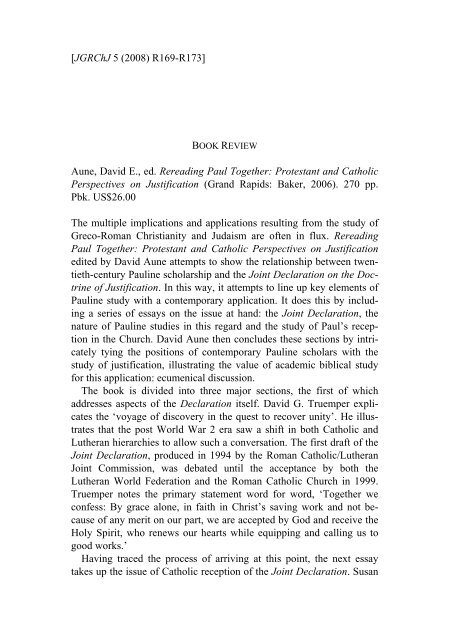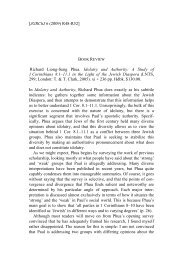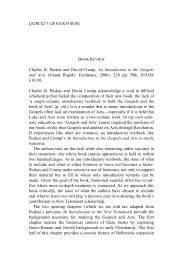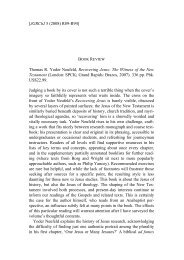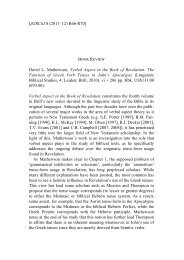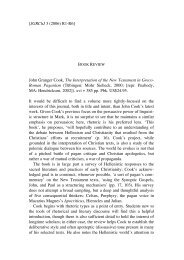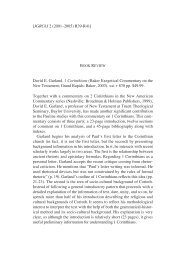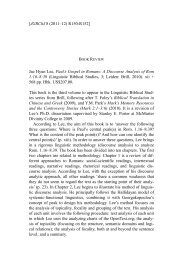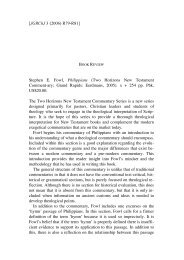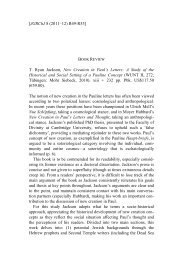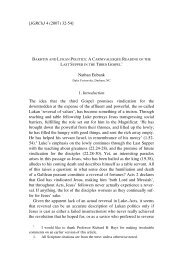David, E. Aune (ed.), Rereading Paul Together - Journal of Greco ...
David, E. Aune (ed.), Rereading Paul Together - Journal of Greco ...
David, E. Aune (ed.), Rereading Paul Together - Journal of Greco ...
Create successful ePaper yourself
Turn your PDF publications into a flip-book with our unique Google optimized e-Paper software.
[JGRChJ 5 (2008) R169-R173]<br />
BOOK REVIEW<br />
<strong>Aune</strong>, <strong>David</strong> E., <strong>ed</strong>. <strong>Rereading</strong> <strong>Paul</strong> <strong>Together</strong>: Protestant and Catholic<br />
Perspectives on Justification (Grand Rapids: Baker, 2006). 270 pp.<br />
Pbk. US$26.00<br />
The multiple implications and applications resulting from the study <strong>of</strong><br />
<strong>Greco</strong>-Roman Christianity and Judaism are <strong>of</strong>ten in flux. <strong>Rereading</strong><br />
<strong>Paul</strong> <strong>Together</strong>: Protestant and Catholic Perspectives on Justification<br />
<strong>ed</strong>it<strong>ed</strong> by <strong>David</strong> <strong>Aune</strong> attempts to show the relationship between twentieth-century<br />
<strong>Paul</strong>ine scholarship and the Joint Declaration on the Doctrine<br />
<strong>of</strong> Justification. In this way, it attempts to line up key elements <strong>of</strong><br />
<strong>Paul</strong>ine study with a contemporary application. It does this by including<br />
a series <strong>of</strong> essays on the issue at hand: the Joint Declaration, the<br />
nature <strong>of</strong> <strong>Paul</strong>ine studies in this regard and the study <strong>of</strong> <strong>Paul</strong>’s reception<br />
in the Church. <strong>David</strong> <strong>Aune</strong> then concludes these sections by intricately<br />
tying the positions <strong>of</strong> contemporary <strong>Paul</strong>ine scholars with the<br />
study <strong>of</strong> justification, illustrating the value <strong>of</strong> academic biblical study<br />
for this application: ecumenical discussion.<br />
The book is divid<strong>ed</strong> into three major sections, the first <strong>of</strong> which<br />
addresses aspects <strong>of</strong> the Declaration itself. <strong>David</strong> G. Truemper explicates<br />
the ‘voyage <strong>of</strong> discovery in the quest to recover unity’. He illustrates<br />
that the post World War 2 era saw a shift in both Catholic and<br />
Lutheran hierarchies to allow such a conversation. The first draft <strong>of</strong> the<br />
Joint Declaration, produc<strong>ed</strong> in 1994 by the Roman Catholic/Lutheran<br />
Joint Commission, was debat<strong>ed</strong> until the acceptance by both the<br />
Lutheran World F<strong>ed</strong>eration and the Roman Catholic Church in 1999.<br />
Truemper notes the primary statement word for word, ‘<strong>Together</strong> we<br />
confess: By grace alone, in faith in Christ’s saving work and not because<br />
<strong>of</strong> any merit on our part, we are accept<strong>ed</strong> by God and receive the<br />
Holy Spirit, who renews our hearts while equipping and calling us to<br />
good works.’<br />
Having trac<strong>ed</strong> the process <strong>of</strong> arriving at this point, the next essay<br />
takes up the issue <strong>of</strong> Catholic reception <strong>of</strong> the Joint Declaration. Susan
R170 <strong>Journal</strong> <strong>of</strong> <strong>Greco</strong>-Roman Christianity and Judaism 5<br />
K. Wood expresses the Catholic reservations involving the question <strong>of</strong><br />
‘merit’, the simultaneity <strong>of</strong> sin and justification, and the baptismal<br />
theology <strong>of</strong> the two groups. The first two issues make up the bulk <strong>of</strong> the<br />
remaining disagreement and show that the Declaration only articulates<br />
what is agre<strong>ed</strong> and does not resolve all differences on what properly<br />
belongs to a doctrine <strong>of</strong> justification. However, Wood clearly shows<br />
that agreements are made anew, especially with regard to baptism.<br />
The final article pertaining directly to the Declaration illustrates the<br />
methodological shifts in Lutheran systematics that must take place to<br />
truly implement an ecumenical position. Michael Root argues that elements<br />
<strong>of</strong> the Catholic reservations are found historically in the Lutheran<br />
movement itself. He cites Scandinavian Lutherans who have accept<strong>ed</strong><br />
a role for the will, however slight, in the justification <strong>of</strong> the individual.<br />
He also mentions Luther’s own Against Latomus <strong>of</strong> 1521, where<br />
Luther qualifies and exposits the simultaneity <strong>of</strong> justification and a<br />
sinful state. This exposition allows concord with the current Declaration.<br />
These studies into the current religious situations provide the<br />
backdrop for the further discussion <strong>of</strong> biblical scholars on <strong>Paul</strong>’s<br />
doctrine <strong>of</strong> justification.<br />
The second major section contains articles by contemporary <strong>Paul</strong>ine<br />
scholars <strong>of</strong> both Catholic and Protestant backgrounds. Joseph Fitzmyer<br />
argues in a philological manner that justification is merely a single<br />
image <strong>of</strong> a more complete portrait depicting the effect <strong>of</strong> the Christ<br />
event. He cites the close connection <strong>of</strong> qdc and dikai- as cognates<br />
within the LXX. He understands dikaio/w to ‘otherwise mean[t], “to<br />
make or set right”, or “to deem right”’. In this way, he betrays a certain<br />
understanding <strong>of</strong> lexicography as well as a tendency to favor the classical<br />
use, as many <strong>of</strong> his examples emphasize. This argument, simplifi<strong>ed</strong><br />
for the sake <strong>of</strong> readability and interdisciplinary sensitivity, furthers<br />
the book’s previous assertion that justification is not the doctrine<br />
by which <strong>Paul</strong>’s theology rises or falls.<br />
Richard E. DeMaris raises two relat<strong>ed</strong> concerns with Fitzmyer’s<br />
thesis. First, in the contemporary context <strong>of</strong> the ecumenical debate, De-<br />
Maris argues that more attention must be given to the goal <strong>of</strong> both<br />
parties to word the doctrine <strong>of</strong> justification in a manner that contemporary<br />
individuals may understand. The second relat<strong>ed</strong> concern is the<br />
synchronic use <strong>of</strong> the dik- word group. These two concerns are us<strong>ed</strong> to<br />
argue that <strong>Paul</strong>’s use <strong>of</strong> justification terminology directly relates to
Review: AUNE <strong>Rereading</strong> Romans <strong>Together</strong> R171<br />
and challenges imperial formulations <strong>of</strong> justice and applies it to<br />
contemporary discussions <strong>of</strong> justice.<br />
The final essay by John Reumann tracks the major influences in the<br />
study <strong>of</strong> <strong>Paul</strong>’s theology and doctrinal reassessments in the Lutheran<br />
Church. He uses this academic history to articulate common biblical<br />
criticisms <strong>of</strong> the Declaration, diffusing the criticisms, but also leaving<br />
room for biblical scholarship to continue to speak. Reumann articulates<br />
two elements that broaden the traditional Lutheran doctrine canonically.<br />
First, Reumann argues that many <strong>of</strong> the statements on justification<br />
in Romans and Galatians were actually formulations compos<strong>ed</strong><br />
by the pre-<strong>Paul</strong>ine church as a whole and in this way reflect early<br />
apostolic preaching (Gal. 2.16; Rom. 3.28). Secondly, the Philippian<br />
letter (particularly Phil. 3) illustrates a doctrine <strong>of</strong> justification outside<br />
the Galatian controversy and in a broader context. All the scholars in<br />
this section affirm the ne<strong>ed</strong> to broaden the discussion <strong>of</strong> <strong>Paul</strong>’s soteriology<br />
and ecclesiology beyond justification. The Lutheran scholars,<br />
however, make reservations to maintain the biblical nature <strong>of</strong> certain<br />
Lutheran particulars.<br />
The third major section addresses the reception <strong>of</strong> <strong>Paul</strong> in the history<br />
<strong>of</strong> the Church and various perspectives within this field. Margaret M.<br />
Mitchell smoothly transitions from critiquing Reumann to explicating<br />
her particular scholarly enterprise <strong>of</strong> reconstructing Chrysostom’s reading<br />
<strong>of</strong> <strong>Paul</strong>. She counters Reumann’s assertions that Gal. 2.16 and Rom.<br />
3.28 clearly mark separate propositional statements affirm<strong>ed</strong> outside <strong>of</strong><br />
<strong>Paul</strong>’s writings by arguing for their clear placement within the<br />
arguments being made. Continuing to Reumann’s view <strong>of</strong> the Philippian<br />
text, Mitchell employs the reception <strong>of</strong> Philippians by Chrysostom.<br />
She argues that Chrysostom’s struggle with the Marcionites<br />
makes him an indispensable resource for understanding <strong>Paul</strong>’s characterization<br />
<strong>of</strong> his achievements as sku/balon. Chrysostom necessarily<br />
qualifies this, in order to contrast with the Marcionites, that the law<br />
itself is not sku/balon and faith must include works as well.<br />
<strong>David</strong> M. Rylaarsdam, while somewhat detach<strong>ed</strong> from the rest <strong>of</strong> the<br />
book, outlines several receptions <strong>of</strong> <strong>Paul</strong> in the early Church. He begins<br />
by denying two common assertions: that <strong>Paul</strong> was a marginal figure in<br />
the early Church and that a smooth reception <strong>of</strong> <strong>Paul</strong> occurr<strong>ed</strong> in the<br />
early Church. To illustrate this point, Rylaarsdam compares and contrasts<br />
the readings perform<strong>ed</strong> by Origen, Chrysostom and Augustine.<br />
He argues that elements from all three play a role in both Lutheran and
R172 <strong>Journal</strong> <strong>of</strong> <strong>Greco</strong>-Roman Christianity and Judaism 5<br />
Catholic doctrine. Chrysostom’s emphasis on works is pair<strong>ed</strong> with his<br />
understanding <strong>of</strong> the eschatological judgment. Origen’s progressive<br />
eschatology is coupl<strong>ed</strong> with a focus on divinity as oppos<strong>ed</strong> to Chrysostom’s<br />
anthropological focus. Augustine certainly emphasizes more<br />
than both <strong>of</strong> these an interventionist grace and the rescue <strong>of</strong> the will<br />
from depravity. Rylaarsdam thus highlights the diversity <strong>of</strong> <strong>Paul</strong>’s<br />
reception in the early Church, citing particularly the life situations and<br />
texts emphasiz<strong>ed</strong> in these three interpreters.<br />
Finally, Randall C. Zachman discusses the interpretation <strong>of</strong> <strong>Paul</strong> in<br />
the late Middle Ages and early Reformation periods. Thus, he sets<br />
Luther’s reading <strong>of</strong> <strong>Paul</strong> in contrast to Augustine’s interpretation. The<br />
latter emphasizes proper love for God ordering one’s will and emphasizes<br />
Rom. 5.1-5, 7, Galatians 5 and 1 Corinthians 13. The former emphasizes<br />
confidence in God’s mercy and Romans 3–4, 8, Galatians 3<br />
and 1 Corinthians 15. He concludes, ‘For the past four hundr<strong>ed</strong> and<br />
eighty-two years, these two ways <strong>of</strong> reading <strong>Paul</strong> have striven mightily<br />
with each other but have basically play<strong>ed</strong> to a draw.’ This section<br />
clearly notes that a diversity <strong>of</strong> readings is found in the history <strong>of</strong><br />
Christianity, questioning the exclusivity <strong>of</strong> a Reformation reading.<br />
<strong>David</strong> <strong>Aune</strong> adds a substantial concluding article illustrating the<br />
relationship <strong>of</strong> previous and contemporary <strong>Paul</strong>ine scholarship to divisive<br />
issues between Protestants and Catholics. While he notes that many<br />
<strong>of</strong> the recent studies in <strong>Paul</strong>’s theology have attempt<strong>ed</strong> to refine the<br />
Christian theology <strong>of</strong> Judaism rather than to enable ecumenical discussion,<br />
he is able to show that these studies do not hinder the ecumenical<br />
discussion and in several cases aid it. His treatment <strong>of</strong> the data<br />
leans heavily toward describing the New Perspective. He only briefly<br />
mentions the work <strong>of</strong> Martin Hengel and its implication for <strong>Paul</strong>ine<br />
study. While <strong>Aune</strong> spends a good deal <strong>of</strong> space on the Evangelical<br />
response, he ultimately finds this position (as represent<strong>ed</strong> in Justification<br />
and Variegat<strong>ed</strong> Nomism) unconvincing. <strong>Aune</strong>’s conclusion is<br />
somewhat odd in that he spends a great deal <strong>of</strong> time defending a<br />
position that only nominally aids the ecumenical discussion in view. He<br />
concludes his article by extolling the value <strong>of</strong> academic Bible study for<br />
ecumenical discussion.<br />
While this book is intriguing, it makes no hard contribution to the<br />
study <strong>of</strong> <strong>Greco</strong>-Roman Christianity and Judaism. This is ultimately a<br />
rehashing <strong>of</strong> previous studies in light <strong>of</strong> this ecumenical event. However,<br />
the book may have influence as the wind in the sails <strong>of</strong> the New
Review: AUNE <strong>Rereading</strong> Romans <strong>Together</strong> R173<br />
Perspective is running out and justification for further studies must be<br />
present<strong>ed</strong>. There is certainly room, as <strong>Aune</strong> admits, to continue the discussion<br />
using more intricate data and fresher methods. Also, being able<br />
to come at the artifacts <strong>of</strong> <strong>Greco</strong>-Roman Christianity and Judaism with<br />
a full picture <strong>of</strong> its possible implications promotes more discerning<br />
readings. While no new artifacts or positions are discuss<strong>ed</strong> in this collection,<br />
it has implications for the process <strong>of</strong> scholastic study <strong>of</strong> <strong>Greco</strong>-<br />
Roman Christianity and Judaism.<br />
This book is a useful reminder <strong>of</strong> the nature <strong>of</strong> the discipline <strong>of</strong><br />
Biblical Studies, especially in relation to dogmatic commitments. As<br />
the New Perspective sought to refine the Christian understanding <strong>of</strong><br />
Judaism in the first century, the desire to enable ecumenical conversation<br />
could result in a fresh look at the apostle to the Gentiles. These<br />
research questions ultimately make detail<strong>ed</strong> study <strong>of</strong> the artifacts <strong>of</strong><br />
<strong>Greco</strong>-Roman Christianity and Judaism approachable from other key<br />
disciplines. The book is informative to scholars <strong>of</strong> ancient history and<br />
contemporary theology and attempts to bring these two fields into<br />
conversation.<br />
Brad Williams<br />
McMaster Divinity College


